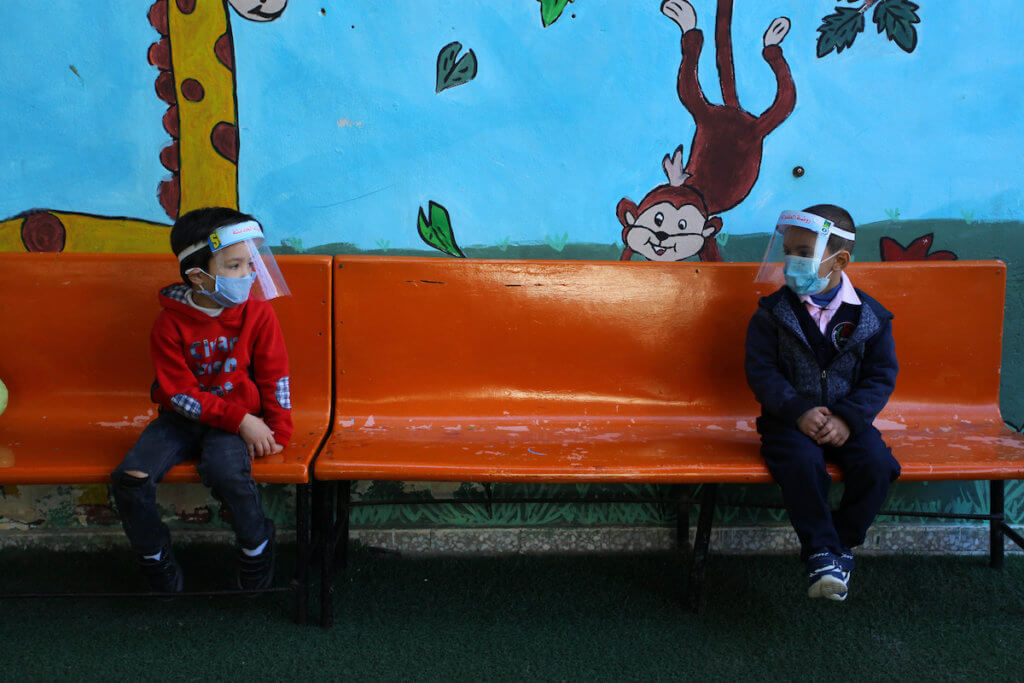A Palestinian women walks past a mural showing mask-clad mourners in the Nuseirat refugee camp in central Gaza on November 16, 2020. (Photo: Ashraf Amra/APA Images)
The Latest:
- 81,294 total Palestinian COVID-19 cases; 69,808 recoveries, 684 deaths
- Of those who tested positive 55,575 are in the West Bank; 12,526 are in East Jerusalem; 13,193 are in Gaza
- 327,748 total Israeli COVID-19 cases; 316,544 recoveries; 2,744 deaths
Over the past week the number of confirmed COVID-19 cases continued to increase in both the West Bank and Gaza, further entrenching November’s trend of a rising second wave with new record levels of cases breaking almost daily. In our last newsletter we told you Gaza hit a record 300 new confirmed cases in a single day that week—well this week that number has doubled. On Wednesday there were 600 new cases confirmed in Gaza.
So how does this impact the overall numbers across the occupied Palestinian territory?
Gaza is clearly experiencing a more intense second wave than the West Bank, but both have increased rates. (When Gaza logged 600 new cases in a 24-hour period, the West reported 651.) What’s more, for two weeks now we’ve seen higher numbers of active cases than recoveries. As of yesterday there were 9,748 active cases. Last Friday it was around 1,500 less, at 8,137.
The growth in cases that we are seeing now can be traced back to early October. At that time there were less than 100 new cases in Gaza recorded in a single day. Then, Gaza’s total number of cases represented about 30% of the overall Palestinian caseload. Last week it was 40% and this week, 50%. Quite a jump.
A stronger second wave

Palestinian children wear masks and face shields inside a kindergarten in Gaza City on November 18, 2020. (Photo: Mahmoud Ajjour/APA Images)
The overall daily totals in this second wave surpassed the peak at the end of the first wave in mid-September. The old record for new cases occurred on September 15. It’s important to note that this time around the numbers from Gaza are around five times higher than it was in early fall, however, the current number of daily new cases in West Bank are still around 200 less that the highest recorded number in September. Although, keep in mind this will likely change in only a few day’s time.
Perhaps a silver lining is the age distribution of cases has remained consistent for months, sparing older Palestinians who are the most venerable. Most of the new cases are from Palestinians under the age of 30. Only 3% are over the age of 70.
Hospitalizations have not dramatically increased this month, although spare beds are hard to come by. While ICUs in the West Bank, East Jerusalem and Gaza are only at 21%, non-critical hospital occupancy is at 87%, the WHO reported. In plan language, 512 of the 590 beds are taken and the number of new cases just doubled over this past week. Hospital capacity must increase to meet the current rates of illness.

(Graph: World Health Organization)
PA ministry of health: real number could be 3 times higher
Once again the United Nations warned there are probably more cases of COVID-19 being transmitting than we know because the numbers are obscured by testing limitations. Around 2,500 were tested per day in Gaza this last week. The population is around 2 million. Only those showing COVID-like symptoms or returning travelers are tested for the coronavirus, the UN said in their latest situation report. “The official figures are believed to significantly underestimate the actual number of people who have contracted the virus.”
The UN went on to say “the true number of cases may be as much as three times higher than the official figure,” according to information they received from the Palestinian Minister of Health, Dr. Mai al-Kaila.
“She attributed the continuing increase in cases to people not abiding by preventive measures and continuing to attend public events, such as wedding celebrations,” the UN added.

A Palestinian sells face masks on the street near a market in Deir al-Balah in the center of Gaza on November 16, 2020. (Photo: Ashraf Amra/APA Images)
Nablus is the new epicenter of the West Bank
Throughout the pandemic we’ve tracked the epicenter of the spread in the West Bank from the first cases in the tourist city of Bethlehem, to the largest and most populous city in the West Bank, Hebron, and now to the latest fulcrum, the mountainside northern city of Nablus.
Second to Gaza, it has the largest portion of active COVID-19 cases, almost 2,000, the UN reported. To combat the spread locally, this week an emergency committee implemented a nighttime curfew in Nablus that is due to expire on Saturday. Three schools were shut down. The village of Kafr ad-Dick in the Salfit area was also put under closure.
Across the West Bank, around 200 of 570 schools are closed or partially closed after teachers or students tested positive for COVID-19.


